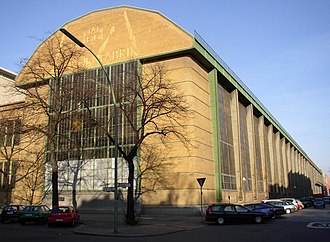AEG turbine factory
The AEG turbine factory at Huttenstrasse 12-19 in the Berlin district of Moabit was built by AEG to manufacture steam turbines for power plants . The turbine hall planned by Peter Behrens and completed in 1909 is one of the best-known industrial architecture buildings outside of Germany .
Today the factory belongs to the Power and Gas division of the Siemens group, which manufactures gas turbines there . It is noteworthy that the product for which the factory was originally built is still being manufactured there.
history

The area initially belonged to Ludwig Loewe & Co. , which together with Thyssen and the US Thomson-Houston Electric Company had founded the Union-Elektricitäts-Gesellschaft (UEG) in 1892 . The company's aim was to enter the growing electrical industry, and so mainly electric trams were produced at this location . But the UEG soon ran into economic difficulties. The expanding AEG group took over the company in 1904 and planned to build a new turbine factory there, as the existing AEG factories were too small for the ever larger steam turbines.
AEG founder Emil Rathenau commissioned the architect Peter Behrens with the construction of the turbine hall. Behrens had been employed by AEG as an artistic consultant since 1907 and designed the company's overall appearance, from the company logo and commercial graphics to the buildings. Initially influenced by the developments in Art Nouveau , the architect soon turned towards the Deutscher Werkbund , which in turn was influenced by the British Arts and Crafts movement.
The construction

The turbine hall was built in 1908–1909 with Behrens as chief architect and civil engineer Karl Bernhard on the corner plot of Huttenstrasse 12–16 / Berlichingenstrasse. The original structure was 25.6 m + 12.5 m wide, 25 m high and 123 m long. In 1939 the hall was extended to the north according to plans by Jacob Schallenberger and Paul Schmidt. The entire building was designed for its function of building large turbines.
The already existing AEG factories in Berlin, such as the Ackerstrasse and Brunnenstrasse factories, were built in the historicist style and mostly known as “crenellated city castles” in which the up-and-coming electrical engineering was hidden under an old-fashioned coat. With the requirement to design an impressive and cultivated building on a grand scale, Peter Behrens created a new industrial architecture that no longer hid behind historicizing facades.
The building has been a listed building since 1956 and was restored in 1978 . On Huttenstrasse (south side) there is a sign from the owner at the time, Kraftwerk Union, with information on construction, architects, monument protection and restoration.
literature
- Landesdenkmalamt Berlin (ed.), Jürgen Tomisch (edit.): District Mitte, districts Moabit, Hansaviertel and Tiergarten. (= Monument topography Federal Republic of Germany , monuments in Berlin ) Michael Imhof Verlag, Petersberg 2005, ISBN 3-86568-035-6 , pp. 292–298.
- Mechthild Heuser: The windows to the courtyard. The turbine hall, Behrens and Mies van der Rohe. In: Hans Georg Pfeiffer (Ed.): Peter Behrens. But who will say what beauty is? Graphics, product design, architecture. Beton-Verlag, Düsseldorf 1990, pp. 108-136.
- Tilmann Buddensieg , Henning Rogge (ed.): Industrial culture. Peter Behrens and the AEG 1907–1914. Gebr. Mann, Berlin 1979, ISBN 3-7861-1155-3 . (2nd edition 1981, 3rd edition 1990, 4th edition 1993)
- Klaus Konrad Weber (Red.): Industrial buildings, office buildings. (= Berlin and its buildings , Volume IX.) Gebr. Mann, Berlin 1971, ISBN 3-433-00553-2 , pp. 50–52, p. 98.
Web links
- Entry in the Berlin State Monument List
- Berlin industrial monuments - AEG turbine hall
- AEG turbine factory. In: arch INFORM .
- Baukammer Berlin - Mitteilungsblatt , issue 4/2010, pp. 29–33
Individual references / comments
- ↑ On the sign, the turbine hall is misleadingly referred to as the “large machine hall”, which in principle harbors a risk of confusion with the “assembly hall for large machines” built by Behrens at the AEG works in Brunnenstrasse a few years later.
Coordinates: 52 ° 31 ′ 41.5 ″ N , 13 ° 19 ′ 28.2 ″ E
